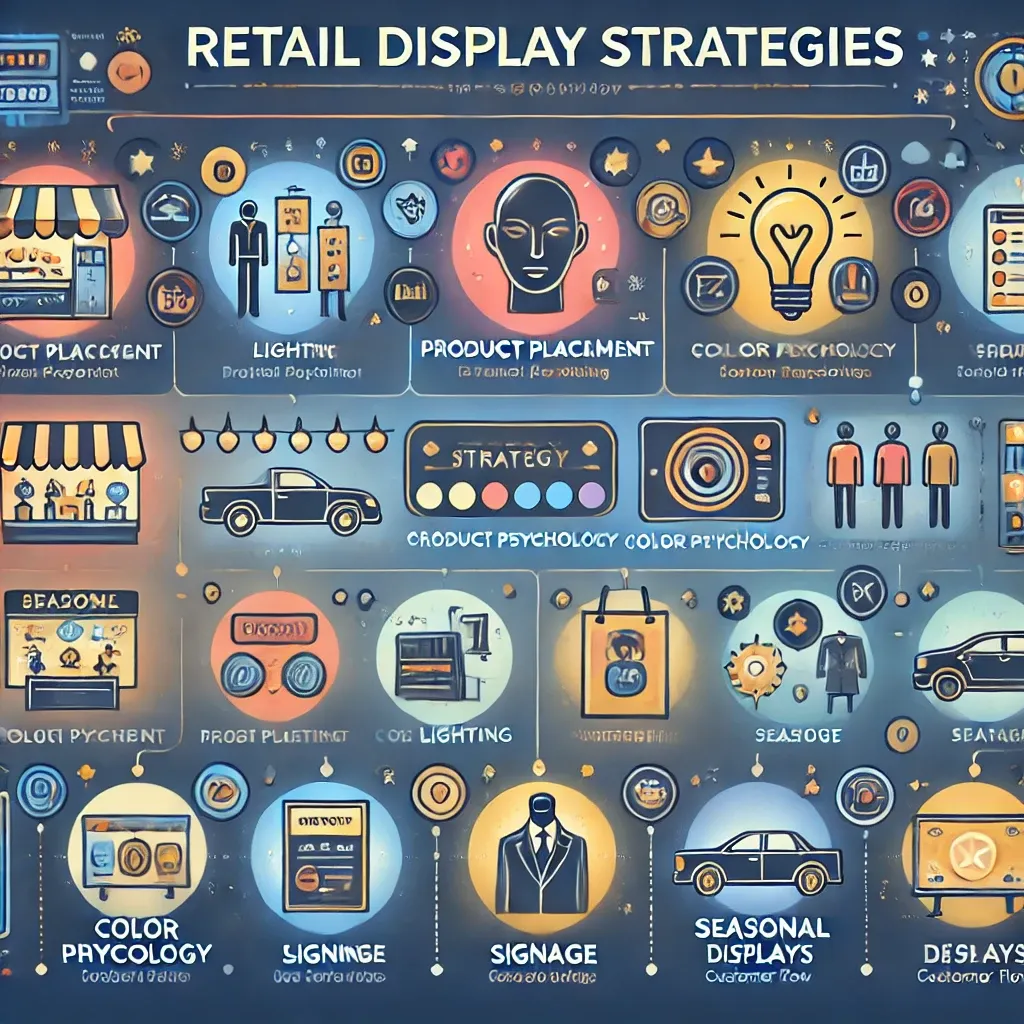Retail Display Strategies

Effective retail display can play a pivotal role in attracting customers, boosting sales, and enhancing the overall shopping experience. The way a store presents its products has a direct impact on how customers engage with the space, decide on purchases, and perceive the store. Implementing the right strategies can make a significant difference in the store's success. Here are twelve strategies to improve your retail display and make your shop more inviting, engaging, and profitable.
1. Follow a Theme
One of the most effective ways to create an inviting retail display is to adopt a cohesive theme that resonates with your brand and products. A theme can set the tone of your store, making it more memorable and attractive to customers.
For instance, a store with a bright, colourful theme, such as a rainbow spectrum, creates a visually appealing atmosphere that grabs attention. This type of display can be especially effective in fashion and home decor, where colour and style play a large role in a customer’s decision-making process.
The key is to ensure that the theme ties together various design elements like colours, furniture, and signage. A well-executed theme can leave a lasting impression and encourage customers to stay longer in the store, increasing the likelihood of a purchase.
2. Cross Merchandising
Cross merchandising is a strategy where products that complement each other are displayed together, encouraging customers to purchase multiple items at once. This technique is particularly effective for increasing the average transaction value.
For example, in a clothing store, combining shirts, trousers, caps, and handbags in a mannequin display can persuade customers to buy the entire ensemble. This not only makes the shopping process easier but also showcases the versatility of the products when combined.
By strategically grouping related products, you make it more likely that customers will see the value in purchasing items they hadn’t initially considered, boosting your store’s overall sales.
3. Keep Displays Portable
Portability is crucial when designing retail displays. Portable displays allow you to easily change your shop layout and highlight specific products, ensuring that your store always feels fresh and dynamic.
For example, portable displays are often used in cosmetic stores, where different brands or seasonal products are showcased on movable racks. This flexibility lets store owners feature new or high-demand products in prominent locations, drawing attention from passersby.
Portable displays can also be used for smaller products like electronics or accessories, providing versatility and making the best use of limited retail space.
4. Use Displays to Educate Customers
Displays can serve as an effective tool for educating customers, especially when they are unfamiliar with certain products. This strategy is particularly important in categories like kitchenware, technology, or beauty products, where customers may need guidance on how to use the items.
For example, a store selling kitchen gadgets can use its display to explain the functionality and benefits of each product. This can be done through signage, videos, or interactive displays that demonstrate the product in action.
Educating customers in-store can help them make informed purchasing decisions and feel more confident about the products they are buying.
5. Use Technology to Enhance Shop Design
Integrating technology into your store design can create an immersive experience that attracts and retains customers. Digital screens, virtual mirrors, and interactive displays are just a few ways technology can improve the shopping experience.
For instance, using a digital display to showcase top designs or trends can draw customers' attention and highlight new arrivals. A virtual mirror, which allows customers to see how clothing looks on them without trying it on, can also enhance the shopping experience and streamline the buying process.
Incorporating technology into your display not only makes your store more modern and innovative but also improves convenience and engagement for the customer.
6. Use Lighting to Feature Products
Lighting is a powerful tool in retail design, as it can draw attention to specific products and create a mood that enhances the shopping experience. Proper lighting can highlight the features and details of your products, making them more appealing to customers.
For instance, instead of using standard overhead lighting, consider using spotlights to emphasise key items, such as premium products or seasonal favourites. Tailoring the lighting to suit the style and purpose of your store can make a significant difference in how customers perceive your products.
The right lighting can create a warm and inviting atmosphere, while also showcasing your products in the best possible light.
7. Change Displays Regularly
Keeping your displays fresh and updated is essential for maintaining customer interest. If a customer visits your store multiple times and always sees the same display, they may lose interest and stop returning. Changing your window and in-store displays regularly keeps the store dynamic and exciting.
For example, seasonal displays or monthly promotional themes can offer new experiences for returning customers, encouraging them to explore different sections of your store. This is particularly important in high-footfall areas where competition for customer attention is fierce.
By refreshing displays regularly, you keep your store interesting and increase the likelihood that customers will make repeated visits.
8. Make Merchandise Easy to See and Buy
Ensuring that your merchandise is visible and accessible is key to a successful retail display. Products should be displayed at eye level to make it easy for customers to browse and make selections.
For example, in a grocery store, items are usually arranged on shelves where they are easy to see and reach. Similarly, clothing stores often place popular or high-demand items at eye level to increase the chances of a sale.
The goal is to make it as easy as possible for customers to find what they are looking for, while also encouraging impulse purchases by placing complementary items nearby.
9. Work on Your Window and Entrance
The entrance to your store is the first thing customers see, and the window display serves as a crucial marketing tool. It’s important to create an inviting and visually appealing window display that attracts potential customers and draws them into the store.
For example, in the case of furniture stores, a well-curated window display that showcases beautifully arranged pieces can give customers a sense of the quality and style of products they can expect inside. Creative window displays can also highlight seasonal themes, new arrivals, or promotions.
A welcoming and attractive entrance not only invites customers to step inside but also sets the tone for their shopping experience.
10. Go for Unusual Display Shapes
Incorporating unusual display shapes can add a unique element to your store’s design and make it stand out from competitors. Instead of using standard box shelves, consider using circular, triangular, or custom-shaped displays to showcase your products.
For example, some brands use product-shaped displays, like creating a bottle-shaped shelf to showcase drink products, or using a tree shape to display food items. These creative displays can intrigue customers and make them more likely to engage with your products.
Unique display shapes can enhance the aesthetic of your store and provide a memorable experience for customers.
11. Encourage Product Testing
Allowing customers to try products before purchasing is a powerful way to build confidence in their buying decisions. When customers can test a product firsthand, it becomes easier for them to make a choice.
For example, in cosmetic stores, offering testers of lotions, perfumes, or makeup products encourages customers to try the products before buying. The “Try Me” signage invites customers to interact with the items, leading to increased sales.
Product testing not only engages customers but also helps to build trust in the quality and effectiveness of your offerings.
12. Keep Prices Visible
One of the most important aspects of retail display is ensuring that prices are clearly visible. If a customer sees a product they like but can’t easily find the price, they may be discouraged from purchasing it, assuming it’s too expensive.
Make sure that all products are clearly labelled with their prices, and consider highlighting special deals or discounts in prominent places to encourage purchases. For example, in a retail store, pricing should be displayed next to the product, either on a tag or on the product shelf.
Visible pricing ensures transparency and helps customers make informed purchasing decisions without any confusion.
Implementing these twelve retail display strategies will help you create an inviting, customer-friendly store environment that encourages sales and enhances the shopping experience. By focusing on presentation, accessibility, and engagement, you can increase customer satisfaction and drive greater business success.
